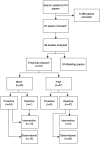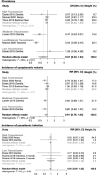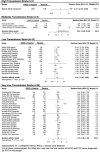Testing and treatment for malaria elimination: a systematic review
- PMID: 37661286
- PMCID: PMC10476355
- DOI: 10.1186/s12936-023-04670-8
Testing and treatment for malaria elimination: a systematic review
Erratum in
-
Correction: Testing and treatment for malaria elimination: a systematic review.Malar J. 2024 Mar 1;23(1):63. doi: 10.1186/s12936-024-04861-x. Malar J. 2024. PMID: 38429746 Free PMC article. No abstract available.
Abstract
Background: Global interest in malaria elimination has prompted research on active test and treat (TaT) strategies.
Methods: A systematic review and meta-analysis were conducted to assess the effectiveness of TaT strategies to reduce malaria transmission.
Results: A total of 72 empirical research and 24 modelling studies were identified, mainly focused on proactive mass TaT (MTaT) and reactive case detection (RACD) in higher and lower transmission settings, respectively. Ten intervention studies compared MTaT to no MTaT and the evidence for impact on malaria incidence was weak. No intervention studies compared RACD to no RACD. Compared to passive case detection (PCD) alone, PCD + RACD using standard diagnostics increased infection detection 52.7% and 11.3% in low and very low transmission settings, respectively. Using molecular methods increased this detection of infections by 1.4- and 1.1-fold, respectively.
Conclusion: Results suggest MTaT is not effective for reducing transmission. By increasing case detection, surveillance data provided by RACD may indirectly reduce transmission by informing coordinated responses of intervention targeting.
Keywords: Active case detection; Malaria; Malaria elimination; Plasmodium falciparum; Proactive; Reactive; Screen and treat; Test and treat.
© 2023. BioMed Central Ltd., part of Springer Nature.
Conflict of interest statement
The findings and conclusions in this report are those of the authors and do not necessarily represent the views of the Centers for Disease Control and Prevention.
All authors declare no competing interests.
Figures





References
-
- WHO, Global Malaria Programme. A framework for malaria elimination. Geneva, World Health Organization; 2017. http://www.who.int/malaria/publications/atoz/WHO-malaria-elimination-fra.... Accessed 29 Oct 2021.

